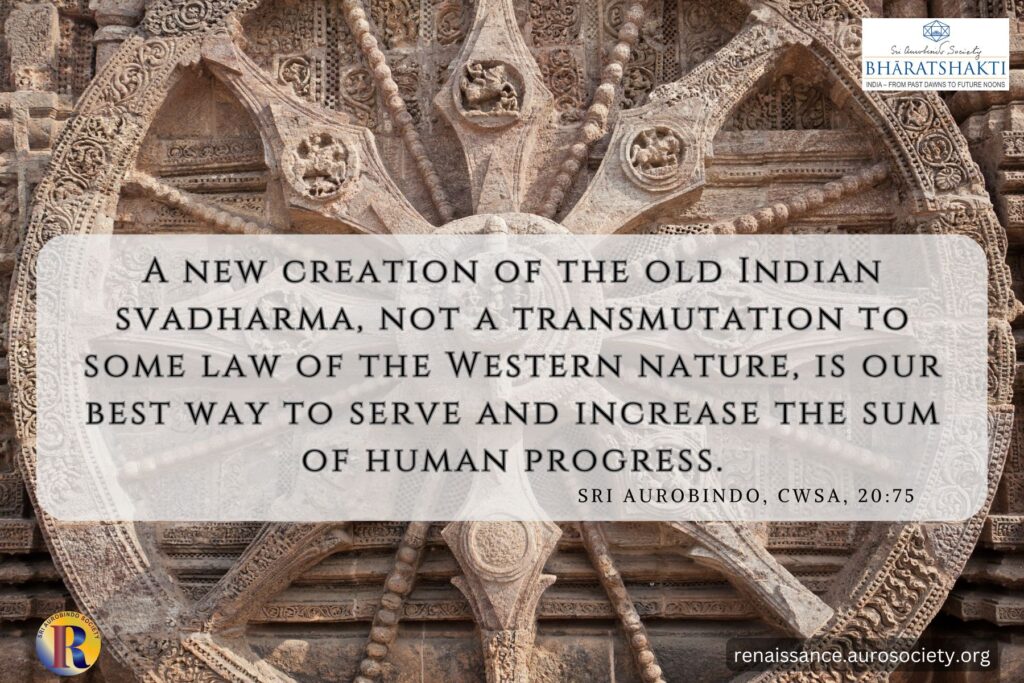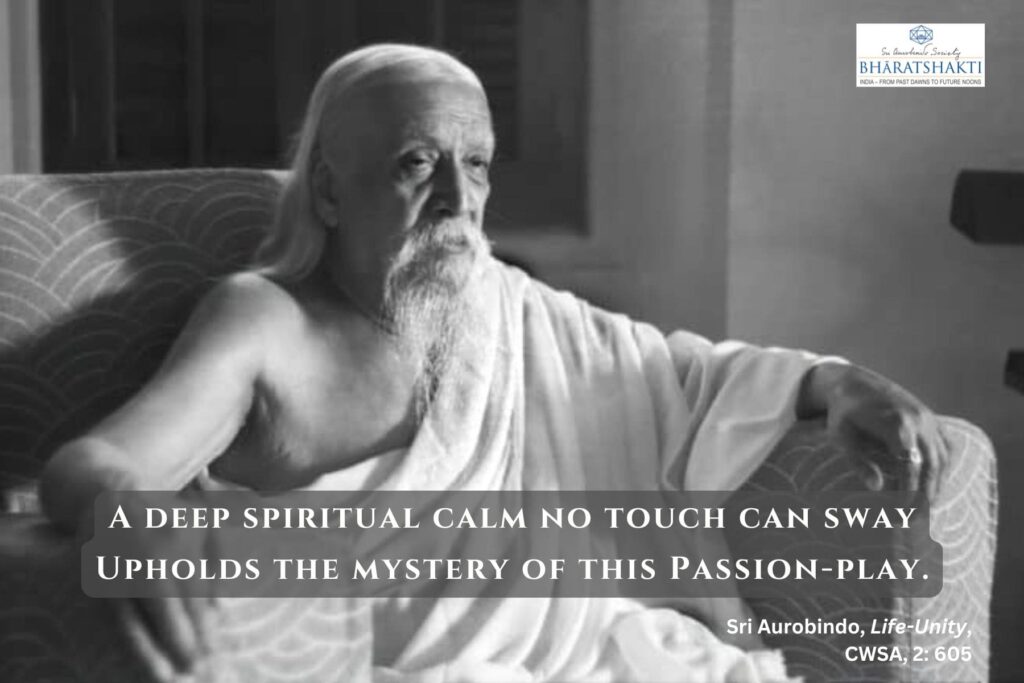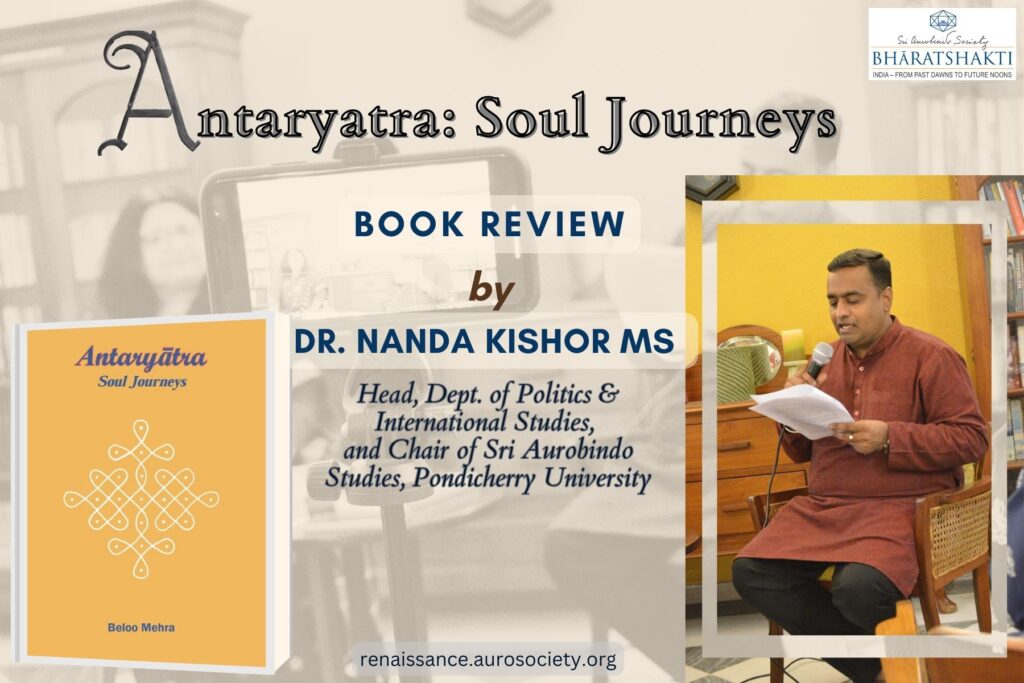Volume 1, Issue 3
Author: Agali Venkappa Sastri
Continued from Part 1
IDEA OF THE MISSION AND THE RACE
Very early in his Uttarapara Speech, Sri Aurobindo said:
“I spoke once before with this force in me and I said then that this movement is not a political movement and that nationalism is not politics but a religion, a creed, a faith. I say it again today, but I put it in another way. I say no longer that nationalism is a creed, a religion, a faith; I say it is the Sanatana Dharma which for us is nationalism.
“This Hindu nation was born with the Sanatana Dharma, with it it moves and with it it grows. When the Sanatana Dharma declines, then the nation declines and if the Sanatana Dharma were capable of perishing, with the Sanatana Dharma it would perish. The Sanatana Dharma, that is nationalism.”
~ CWSA, Vol. 8, p. 12
Nationalism, at first a creed, a religion, a faith as it may well have been with many other nations in their struggle for freedom, becomes in this context something much wider, higher. The truths of the Hindu religion came to be realized by Sri Aurobindo in the Alipore jail with a new and abiding certitude and conviction.
There is a reorientation of nationalism in the light of this realisation whereby nationalism, instead of being an end in itself, becomes auxiliary to Sanatana Dharma which now gives it its whole meaning. Indian nationalism must be as inclusive, as many-sided, as much rooted in God and Humanity, at once as disciplined and liberal, as much one in spirit but myriad in expression as Sanatana Dharma.
What is Sanatana Dharma?
“What is this religion which we call Sanatana, eternal? It is the Hindu religion only because the Hindu nation has kept it, because in this Peninsula it grew up in the seclusion of the sea and the Himalayas, because in this sacred and ancient land it was given as a charge to the Aryan race to preserve through the ages.
“But it is not circumscribed by the confines of a single country, it does not belong peculiarly and for ever to a bounded part of the world. That which we call the Hindu religion is really the eternal religion, because it is the universal religion which embraces all others…
“This is the one religion which can triumph over materialism by including and anticipating the discoveries of science and the speculations of philosophy. It is the one religion which impresses on mankind the closeness of God to us and embraces in its compass all the possible means by which man can approach God. It is the one religion which insists every moment on the truth which all religions acknowledge, that He is in all men and in all things and that in Him we move and have our being.
“It is the one religion which enables us not only to understand and believe this truth but to realise it with every part of our being. It is the one religion which shows the world what the world is, that it is the lila of Vasudeva. It is the one religion which shows us how we can best play our part in that lila, its subtlest laws and its noblest rules. It is the one religion which does not separate life in any smallest details from religion, which knows what immortality is and has utterly removed from us the reality of death.”
~ ibid, pp. 11-12
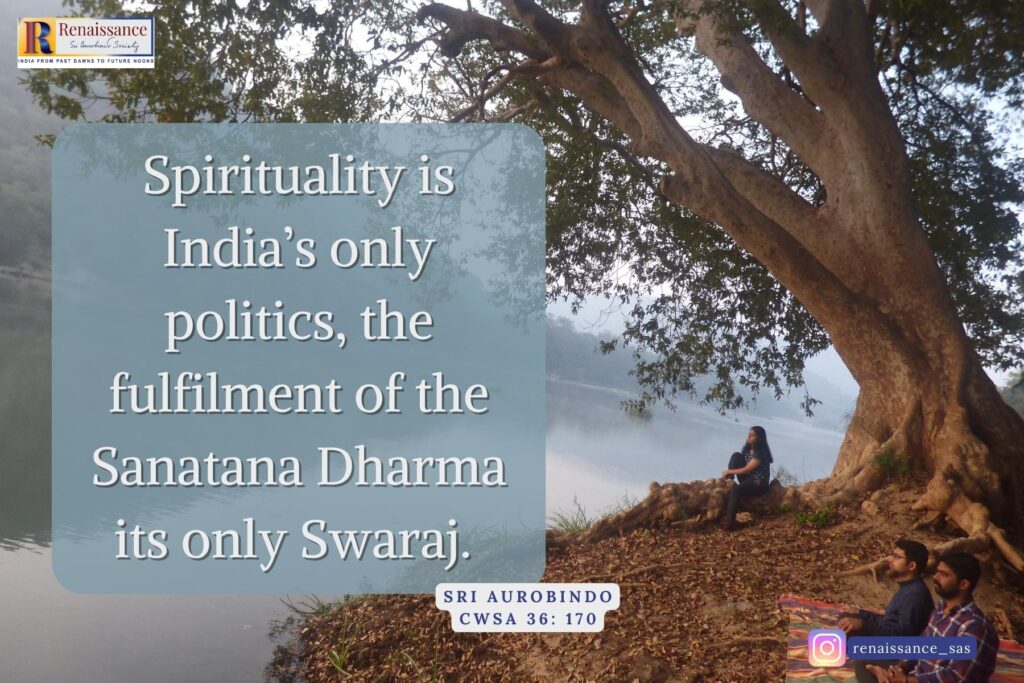
Sanatana Dharma is universal; it is not the religion of a people, it is the truth of spirit, what governs all this Becoming; it is the secret of all evolution, the one multitudinously manifested. Nationalism for the Indian is but an approach to God, a collective adoration of the Highest. “It is for the Sanatana Dharma that they arise.” (ibid, p. 10) Their awakening, emancipation has no meaning unless it feeds this central God-appointed aim.
The rise of India means the rise of Sanatana Dharma of which she is the custodian, the ancient repository. Nationalism will have fulfilled itself only when Sanatana Dharma is perfectly exemplified in the nation, that is, when she accepts all the obligations of this Dharma which is not limited to a country or to a people, when, by the force of this Dharma, we exceed ourselves and find just relationship with other nations, when Humanity is recognised as greater than all nations and when that discovers its meaning in God who is the Transcendent, the Universal and the Individual.
See our Flipbook:
Who is an Aryan?
Who is an ‘Aryan’?
The phrase, “a charge given to the Aryan race to preserve through the ages” in the above quotation touches a dubious chord in the world-mind shaken by German notions which used similar phraseology. The term ‘Aryan race’ is not a variant or synonym of the race theory of the Nordic balefully shouted across the Europe by the Germans.
First propounded by the Frenchman Gobineau in the 1850s and popularised by Houston Chamberlain about the turn of the 20th century and philosophically formulated in Alfred Rosenberg’s ‘Der Mythus des 20. Jahrhunderts’ (1930), the race theory became a justification for German aggression, anti-Semitism and “all the diabolical values or human values exaggerated in the wrong way, until they become diabolical (e.g., the virtues of the Herrenvolk, the master-race)” (CWSA, Vol. 36, p. 466) for which Hitler stood.
‘Aryan’ as Sri Aurobindo uses it, is not an ethnological or anthropological expression; it is a strictly cultural designation.
In the Veda the Aryan peoples are those who had accepted a particular type of self-culture, of inward and outward practice, of ideality, of aspiration. The Aryan Gods were the supraphysical powers who assisted the mortal in his struggle towards the nature of the Godhead. All the highest aspirations of the early human race, its noblest religious temper, its most idealistic velleities of thought are summed up in this single vocable.
In later times, the word Arya expressed a particular ethical and social ideal, an ideal of well-governed life, candour, courtesy, nobility, straight dealing, courage, gentleness, purity, humanity, compassion, protection of the weak, liberality, observance of social duty, eagerness for knowledge, respect for the wise and learned, the social accomplishments.
It was the combined ideal of the Brahmana and the Kshatriya. Everything that departed from this ideal, everything that tended towards the ignoble, mean, obscure, rude, cruel or false, was termed un-Aryan. There is no word in human speech that has a nobler history.
~ CWSA, Vol. 13, p. 441
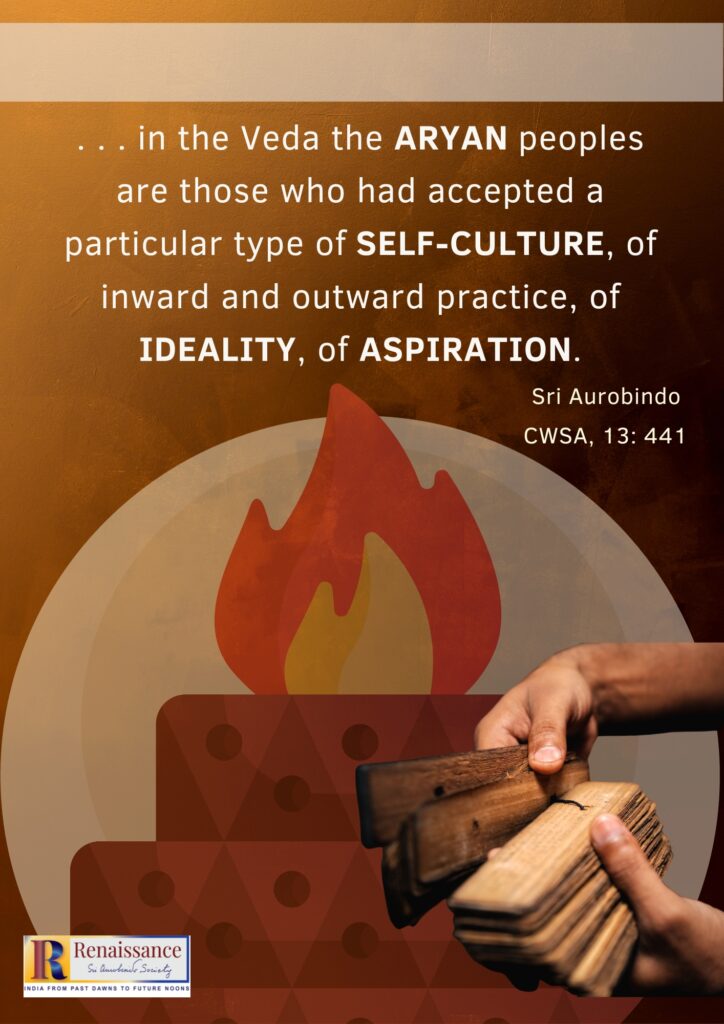
After glancing at the philological and racial implications of the term, Sri Aurobindo proceeds:
Whoever makes that choice, whoever seeks to climb from level to level up the hill of the Divine, fearing nothing, deterred by no retardation or defeat, shrinking from no vastness because it is too vast for his intelligence, no height because it is too high for his spirit, no greatness because it is too great for his force and courage, he is the Aryan, the divine fighter and victor, the nobleman, aristos, best, the sreshtha of the Gita.
Intrinsically, in its most fundamental sense, Arya means an effort or an uprising and overcoming. The Aryan is he who strives and overcomes all outside him and within him that stands opposed to the human advance. Self-conquest is the first law of his nature. He overcomes earth and the body and does not consent like ordinary men to their dullness, inertia, dead routine and tamasic limitations.
He overcomes life and its energies and refuses to be dominated by their hungers and cravings or enslaved by their rajasic passions. He overcomes the mind and its habits, he does not live in a shell of ignorance, inherited prejudices, customary ideas, pleasant opinions, but knows how to seek and choose, to be large and flexible in intelligence, even as he is firm and strong in his will. For in everything he seeks truth, in everything right, in everything height and freedom.
Self-Perfection is the aim of his self-conquest. Therefore what he conquers he does not destroy, but ennobles and fulfils. He knows that the body, life and mind are given him in order to attain to something higher than they; therefore they must be transcended and overcome, their limitations denied, the absorption of their gratifications rejected.
But he knows also that the Highest is something which is no nullity in the world, but increasingly expresses itself here, – a divine Will, Consciousness, Love, Beatitude, which pours itself out, when found, through the terms of the lower life on the finder and on all his environment that is capable of receiving it. Of that he is the servant, lover, and seeker.
When it is attained he pours it forth in work, love, joy and knowledge upon mankind. For always the Aryan is a worker and warrior. He spares himself no labour of mind or body whether to seek the Highest or to serve it. He avoids no difficulty, no cessation from fatigue. Always he fights for the coming of that Kingdom within himself and in the world.
The Aryan perfected is the Arhat. There is a transcendent consciousness which surpasses the universe and of which all these worlds are only a side-issue and a by-play. To that consciousness he aspires and attains.
There is a consciousness which, being transcendent, is yet the universe and all that the universe contains. Into that consciousness he enlarges his limited ego; he becomes one with all beings and all inanimate objects in a single self-awareness, love, delight, all-embracing energy.
There is a consciousness which, being both transcendental and universal, yet accepts the apparent limitations of individuality for work, for various standpoints of knowledge, for the play of the Lord with His creations; for the ego is there that it may finally convert itself into a free centre of the divine work and the divine play.
That consciousness too he has sufficient love, joy and knowledge to accept; he is puissant enough to effect that conversion.
To embrace individuality after transcending it is the last and divine sacrifice. The perfect Arhat is he who is able to live simultaneously in all these three apparent states of existence, elevate the lower into the higher, receive the higher into the lower, so that he may represent perfectly in the symbols of the world that with which he is identified in all parts of his being, – the triple and triune Brahman.”
~ ibid, pp. 442-444
No apology need be made for the length of the quotation as the term is loaded with sinister meaning today and has to be restored to its highest proper significance. Race as generally employed by Sri Aurobindo includes the whole humankind.
India, the Guardian, Exemplary and Missionary
Sri Aurobindo firmly believes in the mission of India, because she is “the hoary guardian of the Asiatic idea and its profound spiritual secrets.” (ibid, p. 137)
There is a mighty law of life, a great principle of human evolution, a body of spiritual knowledge, and experience of which India has always been destined to be guardian, exemplary and missionary.
~ CWSA, Vol. 8, p. 24
God always keeps for himself a chosen country in which the higher knowledge is through all chances and dangers, by the few or the many, continually preserved and for the present, in this Chaturyuga at least, that country is India.
~ CWSA, Vol. 13, p. 71
Every people on earth regards itself as a chosen people. The ancient Israelites, ‘the chosen nation’, the English in Milton’s vision, the Germans with their ‘pure race’, the Italians inspired at one time with Mazzini’s idealism of the mission of nations and later with Fascist militarism have all claimed racial distinction and an apostolic function. It may seem as if the mission of India is just another such national vanity or portentous assumption.
India’s mission does not connote anything imperial or political or narrowly religious, an unctuous variation of the “white man’s burden.” It does not intend a cultural subjugation either, in the sense of India’s culture being imposed on the rest of humanity very much like the British attempt in India, however benevolently conceived.
India’s culture is the most thorough-going application of the principle of freedom and self-determination for the benefit of the smallest cultural units signified by the basic concepts of svabhāva [1] and svadharma [2]. The governing rule of unity in difference is a guarantee of the preservation of all patterns evolved by the Spirit.
India’s mission among the nations would be:
– to uphold the religion of the Spirit,
– to affirm that matter, life and mind are not the last term of evolution, that there is a Beyond, that this Beyond is but the other pole of our being here on earth,
– to affirm that the cycle of evolution will be completed only by the entire scale, all the planes of consciousness being apprehended in Truth-consciousness, – to seek to raise all relativities to their absolutes,
– to help each people so far as they may be helped to discover their true selves,
– to point to each collectivity its own highest potential,
– to vindicate spiritual values,
– to strive for the sovereignty of Dharma, in short, help to establish the Kingdom of God on earth, not in any narrow theocratic sense of sectarian rigidity but a reign of the Spirit in its plastic, spontaneous infinity of expression.
Continued in Part 3…
Cover image: Bhārata Mahima, by Ritam Upadhyay
Design: Beloo Mehra

